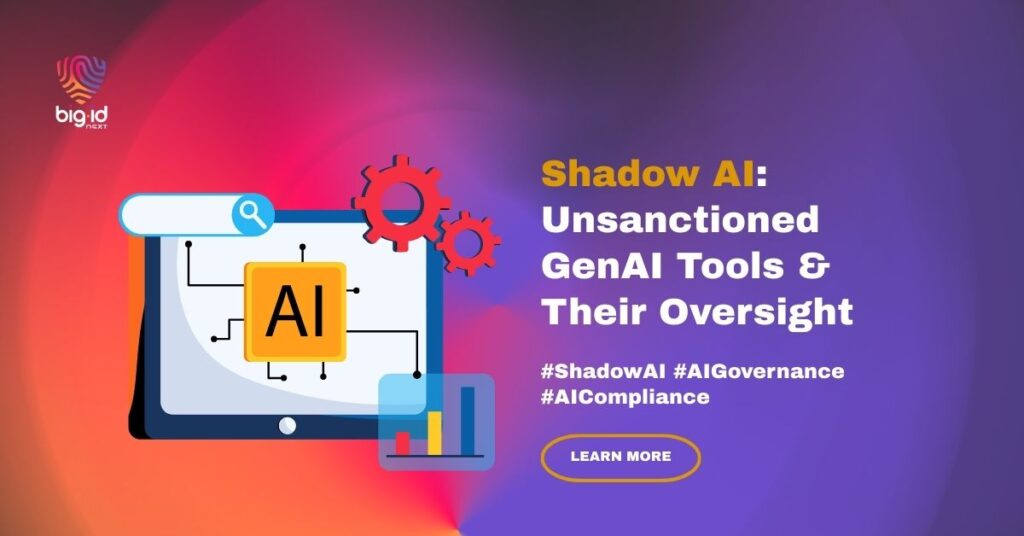Shadow AI and How to Manage Its Risks
We’ve discussed shadow data and how it is a security threat, but were you aware of Shadow AI?
If the term is unfamiliar, read on as we explain what it is. We’ll also explain how it can be a data security hazard for your organization. However, it is possible to use AI to your advantage and mitigate the risks it poses. Let’s find out how.
What Is Shadow AI?
Shadow artificial intelligence is any generative AI or automation tool that isn’t approved or overseen by your company’s IT department.
For example, let’s say an employee uses ChatGPT to create a report or draft an email. That’s not a very far-fetched scenario, seeing as it has 400 million active weekly users, as of March 2025. However, this use of shadow AI hasn’t been sanctioned or authorized by your IT team.
As is the case with shadow data, you can’t govern what you aren’t aware of. Any tool that hasn’t been through a security review has the potential to be a risk. Shadow AI is no different. These unauthorized AI tools can pose security risks to your data and business.
The Significant Risks of Shadow AI
Using AI tools without proper oversight can be a security and compliance disaster. Here are some of the risks unsanctioned use of AI presents:
Potential Data Exposure
When using an AI tool, employees might inadvertently give out proprietary business data or sensitive personal information of customers. For example, if they use AI to help with a report, they may upload a PDF or paste information, without considering if there’s any confidential data being exposed.
Most people think of a generative AI system powered by a large language model (LLM) as their personal assistant or a confidante with whom they can talk privately. In reality, it’s third-party software owned by someone outside the organization. Any information you share with it can be potentially used in its training. Since you haven’t got any safeguards for it, the data can be exposed in the model’s answers.
Wrong or Biased Answers
If a generative AI model isn’t sure of the correct answer, it can ‘hallucinate’ or provide you with made-up information. Its outputs can also be biased against certain groups of people, depending on its training data.
As a result, your employees could end up with false information. This could affect their work or even the reputation of your business, if the resulting hallucination is against your company’s values or ethics.
Regulatory Issues
We mentioned how your employees might unwittingly provide an AI model with sensitive information about your business or customers. The consequence of this act can be more than just data exposure; such information is covered by data privacy laws. If this data is shared without consent and it’s disclosed, your business might face legal action or fines related to data protection.

The Benefits of Using AI Technology
Of course, while shadow AI is a problem, using AI systems for automation or GenAI for work can bring several benefits. Here are some of them:
Enhanced Efficiency
Automation can make certain repetitive tasks easier and faster to complete. More importantly, AI can carry them out without errors. As we know, any process involving the same steps over and over again leads to fatigue. As soon as concentration flags, the risk of making mistakes goes up.
AI, on the other hand, doesn’t get bored and can complete a task the thousandth time with as much focus and accuracy as the first time.
Increased Productivity
Repetitive tasks are more than just boredom-inducing—they are also time sinks that could be automated with generative AI tools. By handing them over to AI tools, your employees get more time for tasks that require human creativity and thought.
Personalized Customer Interaction
A lot of customer interactions have been automated. However, AI tools take customization further. Such a tool can offer suggestions on products and services to offer the customer in real time. This makes your interactions more relevant, which makes it a positive experience for them. That, in turn, helps build brand loyalty and creates a stronger relationship.
Better Security and Governance
It is impossible for a human—or even multiple humans—to monitor all data and network activity and identify suspicious behavior and access. AI, on the other hand, can tirelessly scan for anomalies and unauthorized sign-ins, and prevent security incidents before they escalate.
How to Mitigate Shadow AI Risks
If your employees are using AI solutions without your authorization, they’re doing so for a reason. Maybe it’s because your approved tools are too slow or limited, or maybe they aren’t aware of the risks.
You may try to stop them, but the truth is, if it helps them perform better or faster, you could use AI to your advantage. All you need to do is create policies that help you better manage the risks of shadow AI.
Here’s how you can do that:
Evaluate Your Risk Appetite
How much risk can your organization afford to take? What regulations must your business comply with, and how do you ensure compliance? Where are the vulnerabilities in your business, and how would any attacks on these affect you and your reputation?
Once you know your limits, you can create an AI adoption plan, starting with the lowest-risk scenarios and applications.
Build Your AI Governance Program Gradually
Instead of trying to overhaul your systems in one go, start with AI tools in contained environments or with specific teams. Once you are satisfied with the results, build up the usage and refine your governance policies accordingly.
Create an AI Usage Policy
Instead of waiting for an employee to share the wrong data with an AI model, pre-empt such issues by proactively creating AI policies. Define what can and can’t be shared with these systems, and how they should be used. If you don’t want certain use cases to be adopted by your teams, make it clear.
Also, ensure that any new AI project is evaluated and approved by your IT team. And, don’t forget to regularly review your policies to keep them aligned with new technologies and processes.
Get Your Employees’ Input
Instead of penalizing your workers for using AI tools without permission, find out what they’re using and why. Their feedback could be useful in highlighting the gaps in your technology stack and governance policies. This allows you to either optimize your workflows or find a way of integrating the tool into them, thereby moving them from unsanctioned “shadow AI” to legitimate AI tools.
Ensure Consistency Across Departments
When integrating AI tools into your business, make sure that IT, operations, and governance departments are aligned.
For example, operations might want to use the tool in a way that compromises security. Or IT evaluates the tool for security but doesn’t understand the need for privacy in this assessment, which is the main concern for governance. By bringing all these departments together, you will create better policies for responsible AI use and oversight that work for everyone.
Train Employees on AI Use and Associated Risks
Like we said earlier, employees might use shadow AI indiscriminately because they aren’t aware of its dangers. By investing in training and education, you inform them of potential pitfalls. At the same time, you train those unfamiliar with such tools so they can utilize them effectively as well. Whether it’s GenAI or AI-powered automation, using it responsibly helps reduce your security vulnerabilities and helps your employees perform better.
Introduce More Advanced AI Tools
Once you’ve used low-risk AI applications to build your AI governance policies and test for security, you can move on to higher-risk tools. Again, introduce them slowly and assess their impact before opening them up for general use across the business.
Regularly Audit for Shadow AI
As technologies evolve, your employees might find better AI tools to use without clearing them with the IT department. This shouldn’t be the case if you keep asking for their feedback. However, to be absolutely sure, keep monitoring for shadow AI. If you do discover it, evaluate whether it should be queued for review for potential adoption, or forbidden.
How BigID Helps Manage Shadow AI Risks?
The BigID platform helps organizations enforce policies for AI security and governance. It also helps you detect shadow AI usage across your business by monitoring for model files in unstructured data sources, scraping emails for AI service comms, and scanning code repositories, among other things.
Use BigID to implement the AI Trust, Risk, and Security Management (AI TRiSM) framework. If you’re interested in learning more about how the platform can help your business manage its shadow AI (and shadow data) risks effectively, book a live 1:1 demo with our AI governance and security experts today!



